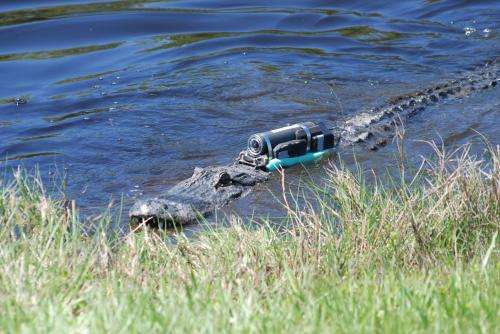Crittercam captures crocodilian foraging behaviors

Animal-borne camera reveals that alligators may attempt to capture prey most often at night, even though the calculated probability of catching prey is highest in the morning, according to a study published in PLOS ONE on January 15, 2014 by James Nifong from the University of Florida and colleagues from other institutions.
Observing the behaviors of dangerous and cryptic predators like alligators is no easy task, so scientists used animal-borne cameras to monitor alligators capturing prey and their other activities. A total of fifteen adult alligators from Merritt Island National Wildlife Refuge and Guana River in coastal Florida were equipped with Crittercam. Afterward, scientists retrieved the video data to determine the frequency and successes rates of alligator foraging behaviors throughout the day.
The video footage revealed that time of day significantly affected the frequency of attacks on prey, as well as the probability of capturing prey. Alligators most often attempted to capture prey during the night, but the researchers' calculated probability of successful capture was highest in the morning and sequentially lower during day, evening, and night, respectively. Position in the water—submerged versus at the surface—also significantly affected prey-capture success, with two-fold greater capture rate when submerged while attacking prey. These estimates are the first for the wild adult American alligator and may provide rare insight into crocodilian foraging behaviors.
"Using Crittercam we gain insight into the behavior and ecological interactions of an important top-predator, the American alligator, in coastal estuaries. We discovered that alligators forage at all times of the day, but increasingly during the night and evening hours, however they were most successful in the morning and while attacking prey below the surface," authors said.
More information: Nifong JC, Nifong RL, Silliman BR, Lowers RH, Guillette LJ Jr, et al. (2014) Animal-Borne Imaging Reveals Novel Insights into the Foraging Behaviors and Diel Activity of a Large-Bodied Apex Predator, the American Alligator (Alligator mississippiensis). PLoS ONE 9(1): e83953. DOI: 10.1371/journal.pone.0083953
Journal information: PLoS ONE
Provided by Public Library of Science



















